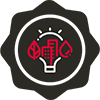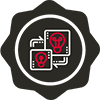2018 Finalists
The shortlisted finalists of the 2018 SICC Awards, in no particular order are:
 Best Green Collaboration
Best Green Collaboration
Collaboration Between Orca Scuba and St Joseph’s Institute International, Singapore
By Orca Scuba & SJI-International Singapore
Two institutions, sharing a sense of urgency to help save our oceans, combined their efforts in this project. Orca Scuba offers a framework to connect Primary, High School and University Students with the oceans and with each other, in order to leverage conservation ideas, thoughts and efforts. SJI-International Singapore is focused on motivating its students to think out of the box. Our collaboration was designed to generate a new generation of thought leaders, business people and activists that would have the drive and ability to change the world’s perception on global warming and associated topics, such as overfishing, coral conservation, shark finning and marine mammal eradication.
From Waste to Resource: Giving Wet Wipes a Second Lease of Life
By Kimberly-Clark Asia Pacific & EWT Centre of Innovation, Ngee Ann Polytechnic
Thinking differently about design, manufacture and disposal has enabled Kimberly-Clark to harvest value from waste materials and keep its products and packaging in the value chain as long as possible.
One such example is an innovative waste management project at its Singapore Tuas mill, which manufactures Huggies baby wipes for the region. During the production process, the wipes are trimmed into squares, leaving behind tonnes of ‘trim waste’ to be disposed of.
Through a research partnership with Ngee Ann Polytechnic’s Environmental & Water Technology Centre of Innovation (EWTCOI) and waste management company Technochem, a sustainable solution for the trim waste was identified: as a pre-treatment drying agent in industrial waste treatment.
While the starting point was to reduce the amount of waste sent for incineration, the collaboration has led to a game-changing technology that has given the 300 tonnes of wet wipe trimmings produced annually a second lease of life, turning them into a valuable resource for a different industry.
Kallang Pulse
By Schneider Electric South East Asia (HQ) Pte Ltd & Sun Electric Pte Ltd
This project is a collaboration between Schneider Electric and Sun Electric (Singapore’s first ever licensed Solar energy retailer) to reduce the carbon footprint of Schneider Electric’s new hub office in Kallang, a retrofitted commercial building that consolidates our existing regional and local operations under one roof.
Spanning 18,584 sqm and home to over 1,200 employees, the premise is Schneider Electric’s first building in Asia to use a hybrid electricity power source, with 45 per cent solar power and 55 per cent natural gas through this collaboration.
This project is aligned to Schneider Electric’s Global Sustainability objective of reducing our CO2 footprint by 80% by 2020. The use of renewable energy resources also supports green and sustainable practices under the Platinum Green Mark scheme, paving the way for other building owners to embark on an Energy Excellence Journey. The project also advances the Building Construction Authority’s goal of championing the growth of green buildings in Singapore.
 Best Technological Collaboration
Best Technological Collaboration
Bridgestone Tirematics
By NCS Pte Ltd & Bridgestone Corporation
NCS has been a key partner in Bridgestone’s digital transformation over the last 6 years throughout the adoption of the latest Cloud, IoT and Big Data solutions.
Bridgestone Tirematics is a combination of sensors and powerful cloud-based alerting engine for real-time monitoring of tire pressure and temperature for commercial vehicles. The system automatically alerts service managers and drivers via email or SMS when abnormal tire air pressure or temperature is detected. Tirematics is part of Bridgestone’s commitment to easier, safer, smoother and seamless mobility for the society and its customers through innovative technology.
Project Arrow – Augmented Reality on Ramp Operations Workforce
By SATS Ltd. & EON Reality Pte Ltd
SATS collaborated with EON Reality to harness Augmented Reality (AR) and Smart Glasses to revolutionize ramp operations in the aviation industry. The ergonomically-designed smart glass will provide SATS’ ramp handling staff with critical information such as loading instructions in real-time. Using the wearable AR technology, operators will be able to scan visual markers found on baggage and cargo containers that provide details such as weight, unit number, loading sequence and the allocated position within the aircraft. This hands-free process improves safety, and increases the accuracy and efficiency of baggage and cargo loading.
Singapore Perfume Filling Line 302
By Procter & Gamble International Operations SA Branch & Feige Filling Technology Asia Pacific Pte Ltd
Singapore houses P&G’s first perfume manufacturing facility in Asia. As a plant which would lead the implementation of new process work flows and technologies for P&G worldwide, it plays a prominent role in driving the company’s global perfume business. The project is to increase the production capacity by adding a new packing automation line with Feige’s filling machine.
Talking to IOT Devices in Text and Voice Naturally
By Robert Bosch (SEA) Pte Ltd & Unified Inbox
The collaboration between Bosch and Unified Inbox integrates our IP enabled sensors and devices with the UnificationEngine platform which bridges the gap to users preferred communications channels such as Whatsapp, WeChat or FB Messenger. This allows users of our connected products and services to talk (text and voice) to them in natural language – without the need to download an additional app. Users can command and control actions, query a status or ask questions which are translated into machine language and which then extracts the answers from those devices – both via a cloud to cloud connection or by doing analytics on the edge.
For instance, the Bosch camera can be queried for a latest image or video of the room, how many people are in it, whether changes have happened etc, or, the camera can alert the user automatically when a particular incident occurs. The user sends a simple text or voice message for example on Whatsapp to the Bosch Camera, e.g. “How many people are in the room?” and the integration will automatically deliver the correct answer in natural next in real time.
 Most Scalable Collaboration
Most Scalable Collaboration
Infineon – A*STAR SIMTech Collaboration on Digital Factory Simulation Modeling
By Infineon Technologies Asia Pacific Pte Ltd & A*STAR Singapore Institute of Manufacturing Technology (SIMTech)
An essential element of Infineon’s transformation towards Smart Factory in Singapore is the capability to simulate operational performance for fast evaluation on productivity and operational planning improvements. The first-ever “digital twin” of the entire back-end test operation encompasses all interdependencies amongst resources; and the complexities and constraints of operational flows to serve as a good emulation of the actual test manufacturing system. With this capability, the model also serves as a powerful decision supporting tool at Infineon’s Smart Factory manufacturing control tower.
Building the simulation capability with A*STAR SIMTech, Infineon was able to harness decades of technical knowledge in simulation modeling and analysis and combine Infineon’s leading expertise in test manufacturing to establish a cost effective and innovative digital manufacturing solution. Through the collaboration, we leverage both industry domain expertise, and institutional research and technological capabilities to accelerate not only the development of simulation capability but also the digital transformation of the factory.
Integrated Digital Delivery for Steel Reinforcement Procurement
By Tiong Seng Contractors Private Limited & NatSteel Holdings Private Limited
Conventionally, the procurement of steel reinforcement bars (used in concrete construction) is prepared by the rebar sub-contractor who has to extract relevant information from structural engineer’s design and 2D drawings, and manually compute into Bar Bending Schedule (BBS). The hand-written BBS is submitted to main-contractor for verification (which is difficult, if not impossible, to check) before the order is sent to rebar supplier through fax or email. On the rebar supplier end, a headcount is required to do data entering. The data provided is fragmented, and the process is laborious, time consuming and prone-to-errors.
Tiong Seng and NatSteel collaboratively developed a system to automate steel rebars procurement process. By leveraging on Building Information Modelling (BIM) technology, steel rebars are now modelled digitally, and the system enables BBS to be generated automatically from the BIM model. Through digitalised selection process aided with 3D visualisation under the BIM environment, the main contractor can easily place order for rebars, and the order placed integrates seamlessly into NatSteel’s back-end procurement and production system.
This new integrated procurement workflow empowers accurate and fast information flow from main-contractor (Tiong Seng) to rebars supplier (NatSteel) without having to rely on manual computation by the rebar sub-contractor, leaving the sub-contractor to concentrate at what they are strong at (i.e. tying of rebars). The collaboration leads to quantum leaps in productivity improvement and efficient integration digital delivery in the value chain.
P&G and Racer Technology’s Collaboration on the New SK-II Magnetic Booster
By Procter & Gamble International Operations SA Branch & Racer Technology Pte Ltd
This is the 2nd collaboration for P&G and Racer Technology with better innovation to develop and manufacture the new SK-II Magnetic Booster, SK-II’s first applicator wand that uses Magnetic MicroPulse Technology which is under Patent Application. The latest skincare innovation delivers consistent yet gentle pulsations at 7000 rpm vibration with magnetism to enhance penetration up to 4 times of the key ingredient found in SK-II’s R.N.A.Power series into the skin.
Racer Technology’s key strengths includes technical mastery, flexibility and positive attitude as a reliable partner, were instrumental in the development and execution of the manufacturing process that produced the required industrial quantity needed to successfully launch this product in the market. This resulted in increased sales of SK-II across retail channels in Asia.
Scaled-up Distributed Electricity Generation
By Summit Power International & Wärtsilä
Summit and Wärtsilä collaborated for first time in 1997 when the two companies jointly began developing the 110 MW Khulna Power Project in Bangladesh, the first IPP in the country. Wärtsilä supplied the international development expertise, capital and the power generation technology. Summit provided the local development expertise. This historic project, which also involved other partners, has since grown to 265 MW. Since then, Summit and Wärtsilä have collaborated on ten other power projects in Bangladesh which are all operating successfully. At the current time, the parties are collaborating on a 450 MW power project in Bangladesh which will be the largest reciprocating engine power project in the country and is expected to be constructed in a total period of nine months, which will be a record in Bangladesh.
TOMI – Life Insurance’s First Self-learning AI Chatbot
By Tokio Marine Life Insurance Singapore Ltd & Pand.ai
Tokio Marine Life Insurance Singapore Ltd. (TMLS) worked with Pand.ai to launch the first self-learning AI chatbot in Singapore that makes life insurance easier to understand and more accessible for the public.
The chatbot, TOMI (for Tokio Marine Insurance), empowers the public to understand their insurance coverage independently by providing users with instant and accurate explanations of commonly-used terms in insurance and information on TMLS products and solutions. Powered by Deep Learning for Natural Language Processing (Deep NLP), TOMI is set apart from other chatbots by its ability to understand sentences in colloquial language and Singlish. TMLS is also working with our regional team at Tokio Marine Asia to bring TOMI and its functionalities to other Asian markets where we operate.
 Most Transformational Collaboration
Most Transformational Collaboration
Consolidated Perfume Material Handling and CSDW Sachet Packing Operations
By Procter & Gamble International Operations SA Branch & Skylift Consolidator (Pte) Ltd
The collaboration is on the expansion and development of Skylift’s service capabilities, beyond its traditional ad hoc freight forwarding scope, to in-plant material handling and packaging operations in P&G’s Singapore Pioneer Plant.
Skylift provides a pool of trained & qualified in-plant staff in the material handling operations of P&G’s perfume production module and in the packing operations of the P&G Purifier of Water sachets. This partnership has transformed and sustained how P&G serves our customers not only in Singapore, but also on a globally scale. It enabled P&G to produce and ship an annual capacity of 7’000 metric tonnes of perfume materials shipped to P&G’s global manufacturing sites. The collaboration also enabled to achieve key milestones in P&G’s global CSR program – packing 170 million sachets of P&G Purifier of Water this year, resulting in the 12 billionth liter of clean water for communities worldwide under the Children’s Safe Drinking Water Program. Systems and processes were established in this partnership resulting to improved reliability and more efficient production lines with in-plant staff trained to temporarily supplement any unforeseen gaps in P&G workforce.
Innovation in Workforce Localization Through Collaborative Partnerships
By Edwards Lifesciences Singapore Pte Ltd & E2i
With Singapore as a manufacturing hub since 2005, ELS has been the main producer of Edwards’ heart valve products globally. Due to increasing global demand for ELS products, there has been a need for ELS to embark on a massive hiring initiative in 2016 and 2017. The ability to find local manpower with the right skillsets and mindset and yet can cope with the physical demands of roles has been a constant challenge for ELS.
To overcome this challenge and ensure we meet our patients’ needs, ELS has embarked on a collaboration with e2i to develop a seven-day ‘Readiness Training Camp’ that helps to prepare and assimilate potential job-seekers who are interested to work at ELS, especially for our Heart Valve Specialist roles.
Smart Lighting System for Chemical Preparation
By Mitsuboshi Overseas Headquarters Private Limited & Temasek Polytechnic
Mitsuboshi Overseas Headquarters Pte Ltd (MOH) collaborated with Temasek Polytechnic to develop a smart lighting system that solve a 30-year old long existing problem – wrong chemical compounds being prepared due to human errors for the rubber compounding process. This is the start of the manufacturing process and it is essential to transform crude rubber into a state suitable for shaping the final product. Mitsuboshi Overseas Headquarters Pte Ltd recognized the need to harness technologies for error prevention at this stage of production.
MOH staff and TP students met to brainstorm ideas on how to automate the process. TP students then leveraged their knowledge on computer engineering to develop a simple and low-cost solution. The innovation involved automating the process of identifying and verifying the ingredients for a particular recipe by using visual indicators to highlight the correct ingredients for the operator to collect and weigh.
There was open communication between MOH staff and TP students to share the information necessary to carry out the tasks. This was evident during orientation, project meetings and onsite testing of the system. MOH allowed the students to access their IT system to work on the programming and the recipes of the different compounding process. MOH was supportive of their innovation and fully funded the costs of materials for the new system.
This collaboration helped MOH improve productivity of 14.1%, which translated to a saving of 55 man days per year. The problem of wrong chemical compounds being prepared was 100% eliminated after the new system was implemented. The collaboration had also provided TP students with a valuable experience to apply their skills learnt in school.
The Early Learning Village
By Cognita Asia, Cognita Schools Group, Bogle Architects, Lendlease Singapore Pte Ltd & Architects 61 Pte Ltd
The Early Learning Village represents an extraordinary milestone in International pre-school education with a capacity of over 2100 children aged 18 months to 6 years of age. The Brief stipulated that this ambitious project should be a model for future schools, providing facilities rarely seen in pre-school buildings: external discovery play zones, teaching spaces, swimming pool, multi-purpose hall, and specialist subject classes for art, music and dance. The key challenges were to ensure that the significant volume of the building was not intimidating for small children, to clarify circulation and provide a design that was playful and fun as well as flexible enough to accommodate changing market conditions all while delivering a high level of customer satisfaction.
This also included housing two different schools with two different curriculums, ethos, cultures and environments in the one facility which led to a collaborative approach to the interior design phase. Subsequently allowing each school to showcase their vision into the design strategy which has resulted in two high quality, very distinctive interior architecture schemes.